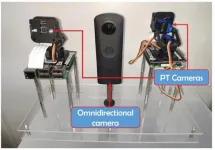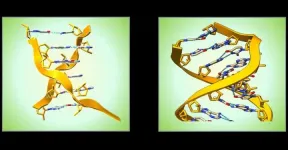INFORMATION:
Screening for ovarian cancer did not reduce deaths
A large-scale randomised trial of annual screening for ovarian cancer, led by UCL researchers, did not succeed in reducing deaths from the disease, despite one of the screening methods tested detecting cancers earlier
2021-05-13
(Press-News.org) A large-scale randomised trial of annual screening for ovarian cancer, led by UCL researchers, did not succeed in reducing deaths from the disease, despite one of the screening methods tested detecting cancers earlier.
Results from the UK Collaborative Trial of Ovarian Cancer Screening (UKCTOCS) have been published in a report in the medical journal The Lancet.
In the UK, 4,000 women die from ovarian cancer each year. It is not usually diagnosed until it is at a late stage and hard to treat. UKCTOCS was designed to test the hypothesis that a reliable screening method that picks up ovarian cancer earlier, when treatments are more likely to be effective, could save lives.
The latest analysis looked at data from more than 200,000 women aged 50-74 at recruitment who were followed up for an average of 16 years. The women were randomly allocated to one of three groups: no screening, annual screening using an ultrasound scan, and annual multimodal screening involving a blood test followed by an ultrasound scan as a second line test.
The researchers found that, while the approach using multimodal testing succeeded in picking up cancers at an early stage, neither screening method led to a reduction in deaths.
Earlier detection in UKCTOCS did not translate into saving lives. Researchers said this highlighted the importance of requiring evidence that any potential screening test for ovarian cancer actually reduced deaths, as well as detecting cancers earlier.
Professor Usha Menon (MRC Clinical Trials Unit at UCL), lead investigator of UKTOCS, said: "UKCTOCS is the first trial to show that screening can definitely detect ovarian cancer earlier. However, this very large, rigorous trial shows clearly that screening using either of the approaches we tested did not save lives. We therefore cannot recommend ovarian cancer screening for the general population using these methods.
"We are disappointed as this is not the outcome we and everyone involved in the trial had hoped and worked for over so many years. To save lives, we will require a better screening test that detects ovarian cancer earlier and in more women than the multimodal screening strategy we used."
Women aged between 50 and 74 were enrolled in the trial between 2001 and 2005. Screening lasted until 2011 and was either an annual blood test, monitoring changes in the level of the protein CA125, or a yearly vaginal ultrasound scan. About 100,000 women were assigned to the no screening group, and more than 50,000 women to each of the screening groups.
Blood test screening picked up 39% more cancers at an early stage (Stage I/II), while detecting 10% fewer late-stage cancers (Stage III/IV) compared to the no screening group. There was no difference in the stage of cancers detected in the ultrasound group compared to the no screening group.
The initial analysis of deaths in the trial occurred in 2015, but there was not enough data at that time to conclude whether or not screening reduced deaths. By looking at five more years of follow up data from the women involved, researchers are now able to conclude that the screening did not save lives.
Professor Mahesh Parmar, Director of the MRC Clinical Trials Unit at UCL and a senior author on the paper, said: "There have been significant improvements in the treatment of advanced disease in the last 10 years, since screening in our trial ended. Our trial showed that screening was not effective in women who do not have any symptoms of ovarian cancer; in women who do have symptoms early diagnosis, combined with this better treatment, can still make a difference to quality of life and, potentially, improve outcomes. On top of this, getting a diagnosis quickly, whatever the stage of the cancer, is profoundly important to women and their families."
Professor Ian Jacobs, from the University of New South Wales (UNSW Sydney), a co-investigator who has led the ovarian cancer screening research programme since 1985 and who was lead investigator of UKCTOCS from 2001-2014, said: "My thanks to the thousands of women, healthcare professionals and researchers who made this trial possible. The multimodal screening strategy did succeed in detection of ovarian cancer at an earlier stage, but sadly that did not save lives. This is deeply disappointing and frustrating given the hope of all involved that we would save the lives of thousands of women who are affected by ovarian cancer each year."
Professor Jacobs noted: "Population screening for ovarian cancer can only be supported if a test is shown to reduce deaths in a future randomised controlled trial. I remain hopeful that a new effective screening test will be found eventually, but it will take many years to conduct a large trial of the test. Realistically, this means we have to reluctantly accept that population screening for ovarian cancer is more than a decade away."
A huge wealth of samples and data from the trial has been donated by the participants for future research. This resource, referred to as the UKCTOCS Longitudinal Women's Cohort (UKLWC), is now being used by researchers worldwide, helping to improve understanding of ovarian cancer as well as other cancers and other diseases such as cardiovascular disease.
Researchers say that the study has also generated insights into how best to design, conduct and analyse a large-scale randomised clinical trial particularly in individuals who have no signs of disease. These insights will be helpful to future trials in all areas of health. It has also contributed to advances in risk assessment, prevention and diagnosis of ovarian cancer.
The UKCTOCS trial was funded by the NIHR Health Technology Assessment (HTA) Programme and the charities Cancer Research UK and The Eve Appeal.
Michelle Mitchell, Cancer Research UK's Chief Executive, said: "Trials don't always find the result we had hoped for, but we need long-term studies like this to know whether new tests save lives. Cancer Research UK will continue to fund vital research into aggressive forms of ovarian cancer so we can reduce the impact of this disease.
"Screening is for people without symptoms, so it's still important that if you notice unusual or persistent changes to talk to your doctor. Symptoms of ovarian cancer can be quite vague and similar to symptoms caused by less serious conditions, which can make spotting the disease tricky. Whether it's needing to go to the toilet more often, pain, bloating, or something else, raise it with your GP - in most cases it won't be cancer but it's best to get it checked out."
Professor Nick Lemoine, Medical Director, NIHR Clinical Research Network, said: "These important findings from a large-scale trial, involving 200,000 participants, show that annual screening did not succeed in reducing deaths from ovarian cancer.
"However, it's important to note that negative results can be as important as positive. The study has provided important new evidence and insights into how to conduct and analyse future large-scale randomised clinical trials into ovarian cancer, in the hope that this will prevent and diagnose this disease more effectively in the future.
"We thank every single person who took part."
Athena Lamnisos, CEO, The Eve Appeal, said: "The threshold for introducing a national cancer screening programme is a mortality benefit. Of course this is key - saving lives. It's disappointing that this research programme did not show a reduction in mortality from ovarian cancer and so can't be recommended as a national screening programme. However, the impact it had on earlier diagnosis is impressive and important.
"Ovarian cancer is so often diagnosed at stage 3 or 4 and shifting diagnosis one stage earlier makes a huge difference to both treatment options and quality of life. Earlier diagnosis will often reduce the amount and intensity of treatment, and this makes all the difference to women and their families who are living with cancer. It may have also given them more precious time with their loved ones."
ELSE PRESS RELEASES FROM THIS DATE:
Epigenetic changes drive the fate of a B cell
2021-05-13
BOSTON - B cells are the immune cells responsible for creating antibodies, and most B cells, known as B2 cells, produce antibodies in response to a pathogen or a vaccine, providing defense and immunity against infections. But a small subset of long-lived B cells, known as B1 cells, are quite different from their short-lived cousins, the B2 cells. Instead of producing antibodies in response to invaders, they spontaneously make antibodies that perform vital housekeeping functions, such as removing waste like oxidized LDL cholesterol from the blood.
Like all the cells in the body, B1 and B2 cells have the same DNA, and therefore the same starting set of instructions. It is through epigenetic modifications, which ...
Politically polarized brains share an intolerance of uncertainty
2021-05-13
PROVIDENCE, R.I. [Brown University] -- Since the 1950s, political scientists have theorized that political polarization -- increased numbers of "political partisans" who view the world with an ideological bias -- is associated with an inability to tolerate uncertainty and a need to hold predictable beliefs about the world.
But little is known about the biological mechanisms through which such biased perceptions arise.
To investigate that question, scientists at Brown University measured and compared the brain activity of committed partisans (both liberals and conservatives) as ...
Two-in-one: Wide-angle monitoring meets high-resolution capture in new camera platform
2021-05-13
If you're a fan of spy movies, you've probably come across scenes where the intelligence agents try to identify or detect a perpetrator using some sophisticated image enhancement technology on surveillance camera images. While the idea behind surveillance cameras and object detection is the same in real life, unlike in movies, there is often a trade-off between the camera's field-of-view and its resolution.
Surveillance cameras are typically required to have a wide field-of-view to make the detection of a threat more likely. Due to this, omnidirectional ...
The first frost is the deepest
2021-05-13
The first frost of autumn may be grim for gardeners but the latest evidence reveals it is a profound event in the life of plants.
The discovery may affect how we grow crops in a fluctuating climate and help us better understand molecular mechanisms in animals and humans.
Much of our understanding of how plants register temperature at a molecular level has been gained from the study of vernalization - the exposure to an extended period of cold as a preparation for flowering in spring.
Experiments using the model plant Arabidopsis have shown how this prolonged period of cold lifts the brake on flowering, a gene called FLC. This biochemical brake also involves another molecule COOLAIR which is antisense to FLC. This means it lies on the ...
Knowledge gaps on opioid use after surgery offer opportunities for improving patient education
2021-05-13
Researchers at Hospital for Special Surgery (HSS) have identified gaps in patient knowledge about pain management and opioid use before total hip replacement, including misconceptions about how much pain relief to expect from opioids after surgery, how to use multiple modes of pain relief (multimodal analgesia) safely and effectively, and proper opioid storage and disposal. These findings were presented at the 2021 Spring American Society of Regional Anesthesia and Pain Medicine (ASRA) Annual Meeting.1
"Patients who are not taught about opioids and pain management may have difficulty with pain control and worse functional outcomes after total ...
Study identifies risk factors for pediatric opioid dependence after surgery
2021-05-13
Researchers at Hospital for Special Surgery (HSS) have identified risk factors for persistent opioid use after surgery in pediatric patients.1 Study findings were presented at the 2021 Spring American Society of Regional Anesthesia and Pain Medicine (ASRA) Annual Meeting.
Previous research indicates that prescription patterns for opioids after surgery in children and adolescents may be associated with long-term use and abuse.2
"Pediatric patients have developing brains that are uniquely vulnerable to addiction, and we need to learn to treat their pain safely without putting them at additional ...
UChicago study finds lasofoxifene a promising treatment for resistant breast cancer
2021-05-13
In a study carried out in mice at the University of Chicago, researchers found that lasofoxifene outperformed fulvestrant, the current gold-standard drug, in reducing or preventing primary tumor growth. It also was more effective at preventing metastasis in the lung, liver, bone and brain, the four most common areas for this cancer to spread.
Additionally, while fulvestrant and similar drugs often cause unwanted, menopausal-like side effects, lasofoxifene prevents some of these symptoms. The research was published on May 13 in END ...
Understanding how people make sense of the news they consume
2021-05-13
How people consume news and take actions based on what they read, hear or see, is different than how human brains process other types of information on a daily basis, according to researchers at the University of Missouri School of Journalism. While the current state of the newspaper industry is in flux, these journalism experts discovered people still love reading newspapers, and they believe a newspaper's physical layout and structure could help curators of digital news platforms enhance their users' experiences.
"Many people still love print newspapers, and to an extent, we also see that they like the digital replicas of print newspapers as much as they do the physical version," said Damon Kiesow, a professor of journalism professions and co-author on the study. "But we believe there ...
A Z-RNA nanoswitch encoded by "junk DNA" turns-off immune responses against self
2021-05-13
In a paper published in the May 13th, 2021 issue of PLOS Genetics, a Z-RNA nanoswitch that regulates interferon immune responses is described. The switch, less than 5 nanometer in length, is based on sequences, called flipons, that change outcomes by altering their three dimensional conformation. The Z-RNA nanoswitch flips from the shorter right-handed A-RNA helix ("on") to the longer left-handed Z-RNA helix ("off"). The flip ends immune responses against self RNAs, but not against viruses. Surprisingly, the Z-RNA nanoswitch sequence is encoded by "junk DNA". The Z-RNA nanoswitch is used by some cancers to silence anti-tumor immune responses. In other cases, a malfunction of the Z-RNA nanoswitch causes inflammatory disease.
In the ...
A sibling-guided strategy to capture the 3D shape of the human face
2021-05-13
A new strategy for capturing the 3D shape of the human face draws on data from sibling pairs and leads to identification of novel links between facial shape traits and specific locations within the human genome. Hanne Hoskens of the Department of Human Genetics at Katholieke Universiteit in Leuven, Belgium, and colleagues present these findings in the open-access journal PLOS Genetics.
The ability to capture the 3D shape of the human face--and how it varies between individuals with different genetics--can inform a variety of applications, including understanding human evolution, planning for surgery, and forensic sciences. ...
LAST 30 PRESS RELEASES:
This new understanding of T cell receptors may improve cancer immunotherapies
A new fossil face sheds light on early migrations of ancient human ancestor
A new immunotherapy approach could work for many types of cancer
A new way to diagnose deadly lung infections and save lives
40 percent of MRI signals do not correspond to actual brain activity
How brain-inspired algorithms could drive down AI energy costs
Gum disease may be linked to plaque buildup in arteries, higher risk of major CVD events
Contrails are a major driver of aviation’s climate impact
Structure of dopamine-releasing neurons relates to the type of circuits they form for smell-processing
Reducing social isolation protects the brain in later life
Keeping the heart healthy increases longevity even after cancer
Young adults commonly mix cannabis with nicotine and tobacco
Comprehensive review illuminates tau protein's dual nature in brain health, disease, and emerging psychiatric connections
Book prepares K-12 leaders for the next public health crisis
Storms in the Southern Ocean mitigates global warming
Seals on the move: Research reveals key data for offshore development and international ecology
Sports injuries sustained during your period might be more severe
World's first successful 2 Tbit/s free-space optical communication using small optical terminals mountable on satellites and HAPS
Can intimate relationships affect your heart? New study says ‘yes’
Scalable and healable gradient textiles for multi‑scenario radiative cooling via bicomponent blow spinning
Research shows informed traders never let a good climate crisis go to waste
Intelligent XGBoost framework enhances asphalt pavement skid resistance assessment
Dual-function biomaterials for postoperative osteosarcoma: Tumor suppression and bone regeneration
New framework reveals where transport emissions concentrate in Singapore
NTP-enhanced lattice oxygen activation in Ce-Co catalysts for low-temperature soot combustion
Synergistic interface engineering in Cu-Zn-Ce catalysts for efficient CO2 hydrogenation to methanol
COVID-19 leaves a lasting mark on the human brain
Scientists use ultrasound to soften and treat cancer tumors without damaging healthy tissue
Community swimming program for Black youth boosts skills, sense of belonging, study finds
Specific depressive symptoms in midlife linked to increased dementia risk
[Press-News.org] Screening for ovarian cancer did not reduce deathsA large-scale randomised trial of annual screening for ovarian cancer, led by UCL researchers, did not succeed in reducing deaths from the disease, despite one of the screening methods tested detecting cancers earlier


